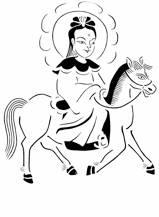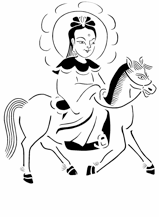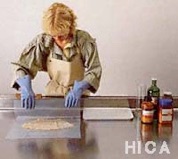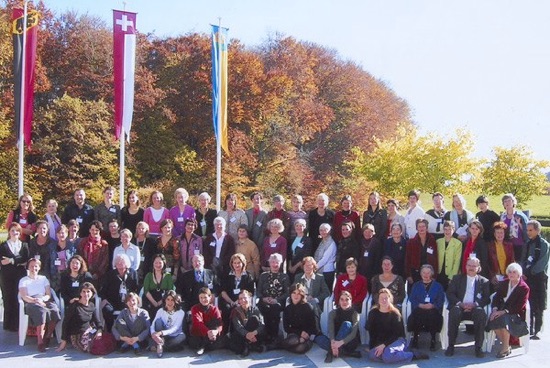The VIIthAlumni Colloquium of the Abegg Foundation
in Riggisberg, Switzerland
October 28 - 30, 2011




The VIIthAlumni Colloquium of the Abegg Foundation
in Riggisberg, Switzerland
October 28 - 30, 2011
The Alumni Colloquium of the Abegg Foundation takes places in Riggisberg near Bern every 3 years. This year the meeting was characterized by two major events: On the one hand, the museum of the Abegg Foundation had been reopened in September after a two-year reconstruction period, and, on the other hand, a new master degree course for textiles-restoration had been established at the Bern University of Applied Sciences.
About 60 alumni students participated at the colloquium. As at every meeting, many interesting presentations of the alumni could be witnessed. Again the presentations were well done and reached a high academic standard. “Everlasting problems in conservation“ as well as “Material combinations“ were the main topics of the conference.
A special highlight was the reopening of the Abegg Museum. After a general welcome, we were given an introduction to the current exhibition together with a tour through the museum. Since August 2009, the previous museum had been modified and even partly been rebuilt. The new building encompasses 1,500 m2 and has been equipped with the most modern technologies, as e.g. with a modern air conditioning system, which provides an ideal exchange of air, ensuring the preservation of the artworks. Furthermore, a quiet ceiling light has been installed as well as subtle LTD-lights around the objects, which create a harmonious and unobtrusive atmosphere. Due to the good composition of the floor – consisting of white tinted oak – and due to the advantageous design of the building, the visitor can walk through the exhibition tranquilly and relaxed. This tour through the museum can be compared to a journey through history (spanning from 400 BCE to 1800 CE) and through many different regions of the earth (e.g. Ancient Egypt, China or Central Asia), a journey relaxed as a meditation.
Besides this, it had been ensured that the number of exhibited objects would stay assessable. It is more reasonable to exchange the objects several times over the year than to overload the exhibition with too many objects and to occupy too much space. It has been decided to change the major topics seasonally. Thus, the visitor can dedicate more time to each of the exhibited objects.
The second important event was the establishment of a degree course in textile conservation/ restoration affiliated to the Bern University of Applied Sciences (BUAS). The studies generally take 5 years. While the theoretical education takes place at the BUAS, the practical learning (practice modules) is achieved at the workshop for textile conservation and in the museum of the Abegg Foundation in Riggisberg. But only one student can be admitted every year. After 3 years, a Bachelor thesis is written, and after 5 years the qualifying Master thesis ensues. In the end, the students are awarded the degree “Master in Conservation-Restoration UAS“. But there are no semester breaks as in other subjects. The students work in the workshop similar to employees. A vacation of four weeks is granted every year. The restoration workshop of the Abegg Foundation is very well equipped. Usually 5 students and 2 interns, supervised by 5 members of staff, are working there at the conservation of objects, most of which belong to the Foundation’s own collection. Currently, a collaboration at a presentation from Rumania is at the center of concern.
The establishment of the Abegg Foundation and of the Textile Museum had been initiated by Werner and Margaret Abegg. The couple’s immense interest in the preservation of valuable art on textiles had been determining and also set the basis for the qualified education of conservators. Today the workshop of the Foundation is world-renowned and the conservators educated in Riggisberg are working in institutions all over the world. What we can witness and admire today is the lifetime achievement of the Abegg family.
Presentations 2011:
Eva Burnham: Two cases that represent extreme settings for conservation work
Dinah Eastop: Promoting preservation & access for books containing textile samples
Hai-Yen Hua-Ströfer: Buddha´s brush – Buddha´s paste (Restaurierung des Taima Mandala)
André Brutillot: Wieviel Ausstellung erträgt eine Tapisserie?
Katharina Neuser und Bettina Niekamp: Die Senkrechthängung des Genesisbehanges - Wunschtraum oder Wirklichkeit?
Dagmar Drinkler: Eng anliegende Bekleidung in Antike und Renaissance
Agneszka Wos Jucker: Unter-Glas-Montagen. Untersuchungen einiger Altmontagen der Abegg-Stiftung
Vallerie Marcelli: Etude et traitement du diorama dit "de la pregarelo" du musée Arlaten d´Arles
Corinna Kienzler: Paramentenschatz der Schwarzen Kirche in Kronstadt, Rumänien - eine kunsthistorische und textiltechnologische Bestandsaufnahme
Caroline Vogt: Phoenix im Gold und Seide-Untersuchungen, Konservierung und Präsentation eines mongolischen Goldgewandes
HICA


Tagebuch
Diary